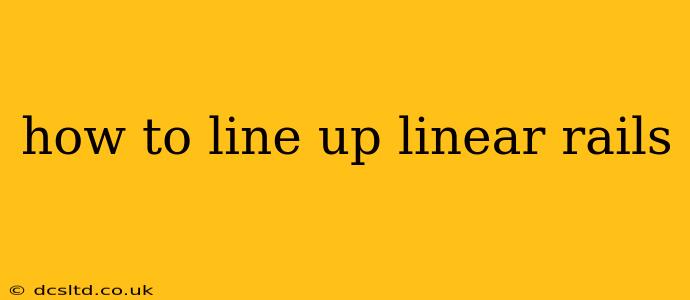Linear rails, also known as linear guides or linear bearings, are crucial components in many mechanical systems, ensuring smooth and precise linear motion. Proper alignment is paramount for optimal performance, longevity, and preventing premature wear. This guide will cover various aspects of aligning linear rails, from preparation to final checks.
Why Precise Alignment Matters
Improperly aligned linear rails lead to several problems:
- Increased Friction and Wear: Misalignment forces the rails and carriages to rub against each other at angles, drastically increasing friction and accelerating wear. This leads to reduced lifespan and potentially catastrophic failure.
- Inaccurate Movement: Precision is often the primary reason for using linear rails. Misalignment introduces inaccuracies in movement, compromising the overall functionality of the system.
- Increased Noise: Friction from misalignment often results in increased noise and vibration, impacting the overall performance and potentially creating a hazardous working environment.
- Premature Failure: The combined effects of increased friction, wear, and stress ultimately lead to premature failure of the linear rails and related components.
Preparing for Linear Rail Alignment
Before you begin the alignment process, ensure you have the following:
- Clean and Level Surface: A perfectly clean and level surface is crucial. Any imperfections will transfer to the alignment of your rails.
- Appropriate Tools: This includes measuring tools (precision levels, calipers, dial indicators), shims (for fine adjustments), and potentially a surface plate.
- Correct Installation Hardware: Use the manufacturer's recommended fasteners and hardware. Improper fasteners can lead to misalignment.
- Understanding of the System: Familiarize yourself with the specific linear rail system you are installing. Manufacturer instructions are crucial.
Steps to Line Up Linear Rails
The alignment process varies depending on the specific rail system and application, but the general principles remain the same. Here's a step-by-step guide:
1. Mounting the Rails
Mount the linear rails to the base according to the manufacturer's instructions. Ensure that the rails are securely fastened and that the mounting surface is perfectly level.
2. Initial Rough Alignment (Visual Inspection)
Visually inspect the rails to ensure they appear parallel and level. Use a straight edge or laser level to check for any gross misalignments.
3. Precise Alignment using Measuring Instruments
This is where precision instruments come into play:
- Leveling: Use a precision level to ensure the rails are perfectly level. Adjust any discrepancies using shims or by carefully adjusting the mounting hardware.
- Parallelism: Check for parallelism using a dial indicator or other precision measuring instruments. Move the indicator along the length of the rails to detect any deviations from parallelism.
- Squareness: Ensure that the rails are square to the mounting surface, especially crucial for applications requiring perpendicular motion.
4. Fine Tuning and Adjustment
Once the initial alignment is complete, proceed with fine-tuning using shims or adjusting the mounting hardware. Small adjustments can significantly impact the final alignment. Use the measuring instruments to verify the changes and fine-tune until the desired precision is achieved.
5. Installing the Carriages
After aligning the rails, carefully install the carriages, ensuring smooth movement along the entire length of the rails. Listen for any unusual noises or resistance—this could indicate misalignment.
Troubleshooting Common Alignment Problems
- Rails not Parallel: Check mounting surfaces for irregularities. Use shims to correct any discrepancies. Ensure all fasteners are tightened evenly.
- Rails not Level: Use a precision level to check the levelness of the mounting surface and the rails. Adjust using shims or by readjusting mounting hardware.
- Binding or Resistance: This often indicates misalignment or obstruction. Check for debris or interference, then revisit the alignment process.
- Uneven Wear: Uneven wear on the rails and carriages is a clear indication of misalignment. Addressing this requires disassembling and realigning the entire system.
Maintaining Linear Rail Alignment
Regular maintenance is critical to maintaining the alignment and prolonging the life of your linear rails. This includes:
- Regular Cleaning: Keep the rails and carriages clean from debris and contaminants.
- Lubrication: Regular lubrication is vital for reducing friction and wear. Use the appropriate lubricant recommended by the manufacturer.
- Periodic Inspection: Regularly inspect the rails and carriages for any signs of wear, damage, or misalignment.
By following these steps and practicing careful attention to detail, you can successfully align your linear rails and ensure the smooth, accurate, and long-lasting performance of your mechanical system. Remember to consult the manufacturer's instructions for your specific linear rail system. They will often provide detailed alignment procedures and specifications.
